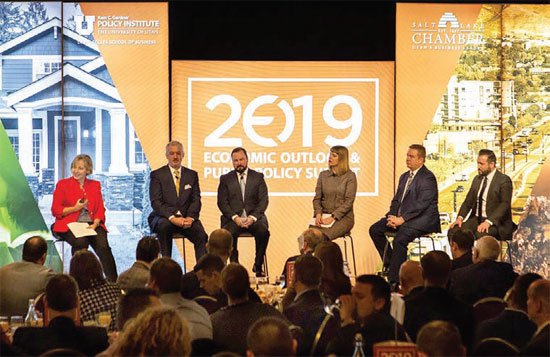By Brice Wallace
Slower growth.
That was the gist of economic forecasts presented recently at the Utah Economic Outlook & Public Policy Summit, but speakers focused on the “growth” component of the phrase.
Juliette Tennert, director of economic and public policy research at the University of Utah’s Kem C. Gardner Policy Institute, noted that the national economic recovery — the longest ever — is expected to hit the 10-year mark this summer.{mprestriction ids="1,3"}
“We do think that maybe the end of the business cycle is starting to come into view, with tapering growth rates that are associated with late cycles,” Tennert told the audience at the annual event, presented by the institute and the Salt Lake Chamber. “But I will remind you that the definition of a recession is an actual decline in economic activity, and absent any unforeseen circumstance, our outlook does not anticipate such an actual decline.”
Utah’s job situation has been “our Holy Grail,” she said, noting that the state added nearly 50,000 new jobs — a 3.3 percent growth rate — in 2018, above both the 2017 rate and the long-term rate of 3.1 percent. But the year-over-year figure slipped to 2.9 percent in November, which Tennert said is “nothing to be alarmed with. It’s something that we’ve been anticipating. It’s very consistent with our expectation of slower growth moving into 2019.”
December’s year-over-year growth rate rebounded a bit, at 3.1 percent. “But, still, it represents that we’re moving into a time of moderating growth,” she said.
Utah’s economy is bolstered by its diversity, its young population, its global connections, the state’s collaborative spirit and its position as the Crossroads of the West, she said. It has seen growth in its population, employment, wages, taxable sales and residential permit value.
The state economy in 2019 will “certainly bear well,” Tennert said. “Growth will be relatively slower, but still we can anticipate steady growth in our state. Our fundamental economic strengths will continue to serve as tailwinds.”
Gov. Gary Herbert said Utah has the nation’s best-performing, most-diverse economy, aided by a low unemployment rate, large job growth, a large middle class and good upward mobility.
“What we’ve heard today reinforces the hard work and what we’ve done, and we’re on the right road and we’re going in the right direction,” Herbert said. “I understand the ups and downs of the business cycle we’ve heard about today. I appreciate Juliette saying [that] because we have a ‘down’ in the business cycle does not mean or equal ‘a recession.’”
Herbert said he does not allow anyone in his administration to “use the R-word,” because he wants to avoid any self-fulfilling prophecy. He even used the term “Great Downturn” to describe the recession, from which Utah emerged better than any other state.
“I certainly reject any kind of gloom and doom, but I’m also wise enough to know that we need to make sure that we do what we can do to insulate ourselves and prepare ourselves as we go forward,” he said.
Tennert said 2018 turned out to be better than many people expected at the same time last year, with the national economy benefiting from federal tax cuts, relatively low interest rates and global growth.
Phil Dean, state budget director and chief economist in the Governor’s Office of Management and Budget, described Utah’s economy and the year 2018 as “strong.” While Tennert said economic concerns include general sentiment and uncertainty, rising costs (including interest rates), Utah’s housing affordability issues, Utah labor constraints, air quality and fiscal sustainability, Dean said risks include national government actions related to trade and fiscal policy, plus labor availability. But Utah also has upsides in the form of large construction projects, including the new state prison, roads and projects in the private sector, he said.
“I do hear a lot of discussion about the potential risks out there,” Dean said. “Again, I think it’s important that we acknowledge those risks, we understand those risks, we track those risks, but I don’t hear as much discussion about the upside potential that’s out there.”
Worries about national trade policy and tightening financial conditions surfaced in the last part of 2018, according to Darin Mellott, Americas director of research at CBRE. “In spite of the fact that growth will taper off … holding all things constant, we think those key factors — in terms of business sentiment and consumer sentiment — are going to allow us to continue going at a healthy rate this year, even if the growth rates do taper off,” he said.
One leading indicator of the national economy is travel, according to the summit’s keynote speaker, Delta Air Lines CEO Ed Bastian. But “the outlook is pretty good,” he said, noting that the company had a $5 billion profit last year.
“Everybody just wants to talk about the dark clouds. Everybody wants to know when the next shoe’s going to drop and are we at the precipice and what does the economic outlook look like, and the travel industry is usually seen as a leading indicator,” he said, stating that spending on travel tends to shrink 90-100 days out from an overall economic slip as people review their discretionary spending, especially for corporate travel.
“Usually if there’s going to be some kind of an economic challenge coming, the first thing that gets cut are travel budgets. … We’re not seeing any negative demand signal at all,” Bastian said.
Delta saw top-line revenue growth of 8 percent last year and is projecting 5 percent for 2019. “We see the rate of growth slowing,” Bastian said, “but it’s still a growing economy.”{/mprestriction}








